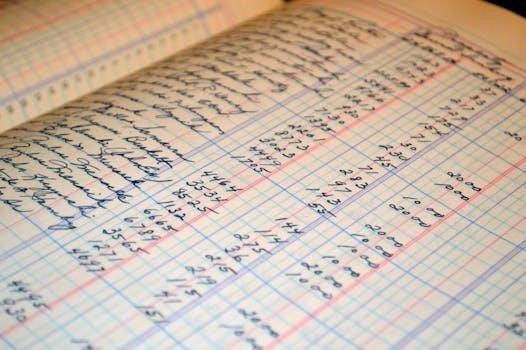Understanding Place Value Charts with Decimals
A decimal place value chart is a visual tool that helps to understand the value of each digit in a decimal number. It extends the place value system to include tenths, hundredths, and thousandths, clearly showing the relationship between whole numbers and fractional parts.
Definition and Purpose of a Place Value Chart
A place value chart is a table that organizes numbers according to their place value. It provides a visual representation of how the position of a digit determines its value within a number. The chart typically includes columns representing ones, tens, hundreds, thousands, and so on, extending to larger values as needed. The primary purpose of a place value chart is to help individuals, especially students, understand the base-ten system and how it relates to the magnitude of numbers. By using a place value chart, one can easily identify the value of each digit in a number and perform operations such as addition, subtraction, multiplication, and division with greater accuracy and comprehension. The chart also aids in reading and writing numbers correctly, ensuring that each digit is placed in its appropriate position. Additionally, place value charts are instrumental in understanding the concept of regrouping or carrying over in arithmetic. They illustrate how ten ones make a ten, ten tens make a hundred, and so forth, reinforcing the foundational principles of number sense. In essence, a place value chart serves as a fundamental tool for building a strong understanding of numerical values and operations.
Importance of Decimal Place Value
Understanding decimal place value is crucial for a wide range of mathematical and real-world applications. Decimal place value extends the concept of place value to numbers less than one, allowing us to represent and work with fractional quantities precisely. Without a solid grasp of decimal place value, individuals may struggle with tasks such as measuring, calculating finances, understanding scientific data, and interpreting statistical information. In mathematics, decimal place value is fundamental for performing operations with decimals, including addition, subtraction, multiplication, and division. It enables us to align decimal points correctly and understand the magnitude of each digit, ensuring accurate calculations. In everyday life, decimal place value is essential for managing money, as prices are often expressed in decimals. It is also vital for understanding measurements in various units, such as meters, liters, and grams, which frequently involve decimal fractions. Moreover, many scientific and technical fields rely heavily on decimal place value for representing and analyzing data. For instance, scientists use decimals to express precise measurements and engineers use them in design calculations. The ability to accurately interpret and manipulate decimal numbers is therefore a valuable skill in these professions. Furthermore, understanding decimal place value fosters a deeper understanding of the number system as a whole, promoting numerical fluency and problem-solving abilities.

Components of a Decimal Place Value Chart
A decimal place value chart is comprised of several key components that work together to illustrate the value of each digit in a number. These components include whole number places, decimal places, and the decimal point, each playing a distinct role.
Whole Number Places
The whole number places in a decimal place value chart represent the digits to the left of the decimal point. These places follow a base-ten system, where each place value is ten times greater than the place value to its right. The whole number places, from right to left, are ones, tens, hundreds, thousands, ten thousands, hundred thousands, millions, and so on. Understanding these places is fundamental to grasping the overall value of a number. For example, in the number 469.24, the ‘9’ is in the ones place, representing 9 units; the ‘6’ is in the tens place, representing 60 units; and the ‘4’ is in the hundreds place, representing 400 units. The whole number places are essential for understanding the magnitude of the number before considering the fractional parts represented by the decimal places. They are a crucial part of the overall place value system, providing a framework for understanding how digits contribute to the total value of a number. The chart visually organizes these places, making it easier to identify and understand the value of each digit. This organization is particularly helpful for students learning about number systems and place value for the first time. Moreover, the whole number places are not limited to just these few; they can extend to billions, trillions, and beyond, following the same base-ten pattern. The understanding of these places is also vital when performing arithmetic operations such as addition, subtraction, multiplication, and division, as the correct alignment of digits according to their place value is necessary for accurate calculations. In essence, the whole number places form the foundation upon which the entire decimal place value system is built, providing a clear and structured way to represent and understand whole numbers.
Decimal Places (Tenths, Hundredths, Thousandths)
Decimal places in a place value chart represent the digits to the right of the decimal point. These places denote fractional parts of a whole, with each place value being one-tenth the value of the place to its left. The first decimal place is the tenths place, representing one-tenth (1/10) of a whole. The second decimal place is the hundredths place, representing one-hundredth (1/100) of a whole. The third decimal place is the thousandths place, representing one-thousandth (1/1000) of a whole, and so on. In the number 469.24, the ‘2’ is in the tenths place, representing two-tenths (0.2), and the ‘4’ is in the hundredths place, representing four-hundredths (0.04). Understanding these decimal places is essential for accurately interpreting and working with decimal numbers. These places allow us to represent values that are smaller than one, providing a way to express precise measurements and quantities. The place value chart visually organizes these decimal places, making it easier to identify and understand the value of each digit after the decimal point. This is particularly helpful for students learning about decimals and their relationship to fractions. The decimal places can extend beyond thousandths to ten-thousandths, hundred-thousandths, millionths, and beyond, with each place value continuing to be one-tenth of the previous place. This system allows for very precise representation of fractional values. The understanding of decimal places is crucial in various real-world applications, such as calculating finances, measuring ingredients in cooking, and performing scientific calculations. Furthermore, knowing the decimal place values helps in converting decimals to fractions and vice versa, reinforcing the connection between these two representations of numbers. In essence, the decimal places in a place value chart provide a structured and intuitive way to understand and work with fractional parts of a whole, enhancing our ability to represent and manipulate numbers with precision.
The Decimal Point as a Separator
The decimal point serves as a crucial separator in a place value chart, distinguishing between the whole number part and the fractional part of a number. It is the reference point from which all other place values are determined. Digits to the left of the decimal point represent whole numbers, increasing in value by powers of ten as you move further left (ones, tens, hundreds, thousands, etc.). Digits to the right of the decimal point represent fractional parts of a whole, decreasing in value by powers of ten as you move further right (tenths, hundredths, thousandths, etc.). The decimal point itself has no numerical value; it merely indicates where the whole number portion ends and the fractional portion begins. Its presence is essential for correctly interpreting the magnitude of each digit in a number. For example, in the number 123.45, the decimal point separates the whole number ‘123’ from the fractional part ‘0.45’. Without the decimal point, the number would be interpreted as ‘12345’, which is significantly different. The correct placement of the decimal point is paramount to accurately representing numerical values. Misplacing the decimal point can lead to gross errors in calculations and interpretations. The decimal point also plays a crucial role in aligning numbers during arithmetic operations such as addition, subtraction, multiplication, and division, ensuring that digits with the same place value are correctly processed together. Visual aids, such as place value charts, emphasize the importance of the decimal point by clearly delineating the whole number and fractional sections. Understanding the function of the decimal point is fundamental to comprehending decimal notation and performing accurate mathematical operations involving decimals. It acts as the cornerstone for understanding place value and representing numbers that fall between whole numbers, allowing for a more precise and nuanced representation of numerical values in various applications, from everyday calculations to scientific and engineering contexts. The clarity provided by the decimal point enables us to easily distinguish between different orders of magnitude and interpret numerical data accurately.

Using a Place Value Chart with Decimals
A place value chart is instrumental in understanding decimal numbers. By placing digits in their respective columns, you can easily identify the value of each digit and learn to read and write decimal numbers correctly. This enhances comprehension and accuracy in math.
Identifying the Value of Each Digit
Using a decimal place value chart is essential for accurately identifying the value of each digit within a number. The chart organizes digits based on their position, indicating whether they represent whole numbers or decimal fractions. To the left of the decimal point, you’ll find the places for ones, tens, hundreds, thousands, and so on, each representing increasing powers of ten. For example, in the number 345, the digit 3 represents 300 (3 hundreds), the digit 4 represents 40 (4 tens), and the digit 5 represents 5 (5 ones). Understanding these positions helps to quickly determine the value of each digit in the whole number portion.
To the right of the decimal point, the places represent fractional parts of one, starting with tenths, hundredths, thousandths, and continuing with decreasing powers of ten. In the decimal number 0.678, the digit 6 represents 6 tenths (0.6), the digit 7 represents 7 hundredths (0.07), and the digit 8 represents 8 thousandths (0.008). Each position to the right of the decimal point represents a fraction with a denominator that is a power of ten.
When using a place value chart, simply place the digits of the number into their corresponding columns. This visual representation makes it easier to see the value of each digit. For instance, if you have the number 123.456, you would place the 1 in the hundreds column, the 2 in the tens column, the 3 in the ones column, the 4 in the tenths column, the 5 in the hundredths column, and the 6 in the thousandths column. This arrangement immediately shows that the 1 represents 100, the 2 represents 20, the 3 represents 3, the 4 represents 0.4, the 5 represents 0.05, and the 6 represents 0.006.
Understanding the value of each digit is crucial for performing arithmetic operations with decimals, such as addition, subtraction, multiplication, and division. It also helps in comparing and ordering decimal numbers. For example, knowing that the tenths place is more significant than the hundredths place allows you to quickly determine that 0.5 is greater than 0.49, even though 49 appears to be a larger number than 5. The place value chart provides a structured and visual way to grasp these concepts, making it an indispensable tool for working with decimal numbers effectively.
Moreover, understanding place value extends beyond basic arithmetic. It is foundational for more advanced mathematical concepts, such as scientific notation, metric conversions, and understanding percentages. For instance, converting a decimal to a percentage involves multiplying by 100, which essentially shifts the digits two places to the left on the place value chart. Similarly, understanding place value is essential for interpreting data and making informed decisions in various real-world scenarios, from finance to science.
Reading and Writing Decimal Numbers
A place value chart is an invaluable tool when it comes to accurately reading and writing decimal numbers. The chart provides a structured framework that helps to translate the numerical representation into its corresponding verbal form and vice versa. When reading a decimal number, start by identifying the whole number part (the digits to the left of the decimal point). Read this part as you normally would for any whole number. For instance, in the number 456.789, the whole number part is “four hundred fifty-six.”
Next, locate the decimal point. This is read as “and.” So, up to this point, our number would be read as “four hundred fifty-six and.” Now, focus on the digits to the right of the decimal point. These digits represent the fractional part of the number. Read these digits as if they were a whole number. In our example, the digits 789 are read as “seven hundred eighty-nine.” Finally, identify the place value of the last digit in the decimal portion. In this case, the last digit (9) is in the thousandths place. Therefore, the complete number 456.789 is read as “four hundred fifty-six and seven hundred eighty-nine thousandths.”
When writing decimal numbers from their verbal form, the process is reversed; Start by writing the whole number part. Then, replace the word “and” with a decimal point. Next, write the digits for the fractional part, ensuring that the last digit occupies the correct place value. For example, to write “one hundred twenty-three and forty-five hundredths,” you would first write “123.” Then, you would add the decimal point⁚ “123.” Finally, you would write “45” such that the 5 is in the hundredths place⁚ “123.45.” If the number were “one hundred twenty-three and five hundredths,” you would need to include a zero in the tenths place to ensure that the 5 is in the hundredths place⁚ “123.05.”
It’s important to pay close attention to the place value names when reading and writing decimals. Common place values include tenths, hundredths, thousandths, ten-thousandths, and so on. Understanding these place values is crucial for accurately representing the fractional part of the number. Additionally, using a place value chart can help avoid common mistakes, such as misplacing digits or omitting necessary zeros.
For example, if you need to write “two and three thousandths,” you would start with “2,” add the decimal point “2.”, and then write “003” to ensure the 3 is in the thousandths place⁚ “2.003;” Without the zeros in the tenths and hundredths places, the number would be incorrectly written as “2.3,” which is “two and three tenths.” By consistently using a place value chart, you can reinforce your understanding of decimal place values and improve your accuracy in reading and writing decimal numbers, both in mathematical contexts and real-world applications.

Free Printable Decimal Place Value Charts (PDF)
Accessing and utilizing free, printable decimal place value charts in PDF format can significantly enhance one’s understanding and application of decimal concepts. These charts serve as readily available visual aids that support learning and practice in various educational settings, from classrooms to home learning environments. The convenience of PDF format ensures easy access and printing, allowing educators, students, and parents to incorporate these charts into their lesson plans and study routines seamlessly.
The benefits of using printable decimal place value charts are multifaceted. Firstly, they provide a clear and organized representation of place values, from whole numbers to decimal fractions, enabling learners to visualize the structure of the decimal system. This visual clarity is particularly helpful for those who are new to decimals or struggle with abstract mathematical concepts. By seeing the place values laid out in a structured format, learners can better grasp the relationship between digits and their corresponding values.
Secondly, these charts offer a hands-on learning experience. Students can actively engage with the charts by writing numbers in the appropriate place value columns, identifying the value of each digit, and practicing reading and writing decimal numbers. This active engagement promotes deeper understanding and retention of the material. Moreover, the charts can be used for various activities, such as comparing decimals, rounding decimals, and performing basic arithmetic operations with decimals.
Thirdly, the availability of free printable charts eliminates the need for expensive textbooks or specialized materials. Educators can easily download and distribute these charts to their students, ensuring that everyone has access to this valuable learning tool. Parents can also use these charts to support their children’s learning at home, providing them with extra practice and reinforcement of decimal concepts.

When selecting a decimal place value chart, it is essential to choose one that is clear, concise, and appropriate for the learner’s level. Look for charts that include a sufficient range of place values, from millions to millionths, to accommodate various decimal numbers. The chart should also be well-organized and easy to read, with clear labels for each place value column. Additionally, consider charts that include examples or practice problems to further enhance learning.

No Responses